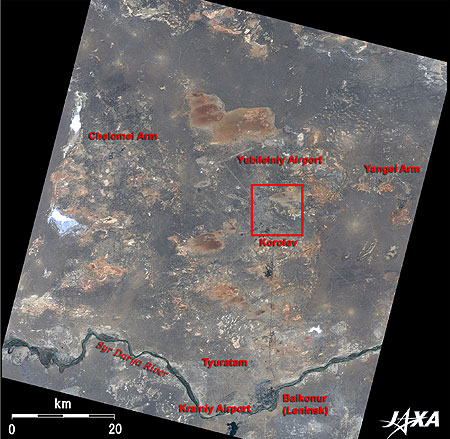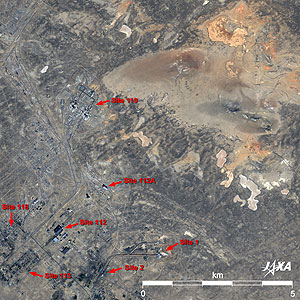Seen from Space 2007
Baikonur Cosmodrome - Launch site of the world's first artificial satellite
Figure 1 depicts Baikonur Cosmodrome as of September 2006. There are vast expanses of semi-arid zones in Central Asia, where layers of bluish gray heavy clay, reddish brown sandy soil, and some white sprinkled salty lakes are seen. The Syr-Darya River can be seen in the south of the image, flowing from its source in the Tian Shan Mountains, tending down to the northwest or west, and flowing into the Aral Sea. A railway runs on the right bank of the river. Around Baikonur station, the center of living and culture, the town of Baikonur (Leninsk renamed in 1995) is seen in dark blue. The railway extends north from Baikonur and branches right and left into Baikonur Cosmodrome. The Cosmodrome extends from Baikonur in the south to Yubileiniy Airport in the north and is composed of three areas. From Baikonur, these are the "Korolev" area located 30km north, "Chelomei" area located in 70km north-west, and "Yangel" area located in 50km north-east. Chelomei contains facilities such as launch complexes for the Proton rockets that have launched some modules of the International Space Station (ISS), the middle-class Tsiklon rockets. Korolev's facilities include the test launch complex for Soyuz rockets. Yangel contains launch complexes for the Soyuz rockets in the operational phase, the Zenit rockets, the Dnepr rockets, and so on. The Cosmodrome is located in Tyuratam, in the Republic of Kazakhstan, about 2,100km south-east of Moscow, Russia, and east of the Aral Sea. Its annual mean temperature is 13°C. In the summer it is dry, and the temperature rises to 45°C, but in the winter it is frosty, windy, and a little rainy with the temperature dropping to -40°C, in the severe typical continental climate. The total area of Baikonur Cosmodrome is about 5,000 km2, almost the size of Chiba Prefecture. There are nine launch complexes and 15 launch pads as well as other facilities. The Cosmodrome is rented by the Russian Federal Space Agency (FSA, Roskosmos) from the Republic of Kazakhstan after its independence in 1991.
With passing time, the Cosmodrome has been expanded, and many lunar explorers, meteorological satellites, military satellites, commercial communications satellites, and manned space ships have been launched from it. On December 2, 1990, a correspondent from Tokyo Broadcasting System, Inc. (TBS), Mr. Toyohiro Akiyama aboard the space ship Soyuz TM-11 was launched by a Soyuz rocket, and on August 24, 2005, JAXA's two satellites, Optical Inter-orbit Communications Engineering Test Satellite "KIRARI" (OICETS) and INovative-technology Demonstration Experiment "REIMEI" (INDEX) were launched piggyback by a Dnepr rocket. The two facilities standing apart from others in the west in Fig. 2 comprise Site 110 for launching the super-heavy booster Energia, which can carry a 100-ton payload into low-Earth orbit. The area south of Site 110 holds many facilities such as Sites 112 and 112A comprising the assembly and fueling station, and Sites 113 and 118, comprising the residential and storage areas. On November 15, 1988, an Energia carrying an unmanned Buran reusable shuttle blasted off from Site 110 left, and two orbits later the Buran automatically landed at Yubileiniy airport. As a stage of daring challenges to realize the expansion of the frontier of human activities, and as an important point linking Earth and space, even further progress is expected.
|






